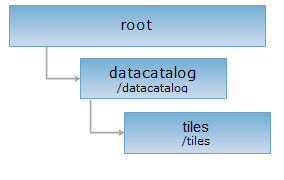
<datacatalog_uri>/tiles[.<format>]
The tiles resource represents the cache data. It can get the entry of importing and exporting operations on the cache data by performing the GET request.
Supported Methods:
Supported output formats: rjson, json, html, xml.

Implement the HTTP request on the following URI, where supermapiserver is the server name, with rjson being the output format.
http://supermapiserver:8090/iserver/services/datacatalog/rest/datacatalog/tiles.rjson
Get the entry of importing and exporting operations on the cache data.
None
GET request in tiles resource is a resource descriptive collection in the entity of response messaging, where the structure of a single resource description is as follows:
| Field | Type | Description |
| name | String | The sub resource name. |
| path | String | Sub resource URL. |
| resourceConfigID | String | The configuration item ID of the resource. |
| resourceType | String | The resource type. |
| supportedMediaTypes | String[] | The media-type of the supported representation. |
The returned rjson format representation after implementing the GET request on the tiles resource is as follows:
[
{
"name": "dataimport",
"path": "http://localhost:8090/iserver/services/datacatalog/rest/datacatalog/tiles/dataimport",
"resourceConfigID": "dataimport",
"resourceType": null,
"supportedMediaTypes": null
},
{
"name": "datas",
"path": "http://localhost:8090/iserver/services/datacatalog/rest/datacatalog/tiles/datas",
"resourceConfigID": "datas",
"resourceType": null,
"supportedMediaTypes": null
}
]
Returns the same HTTP response header as the GET request, but does not have the response entity. It can get the metadata information in the response header without transferring the whole response content. Metadata information includes media type, character encoding, compression encoding, entity content length, and so on.
The HEAD request can be used to determine whether the tiles resource exists or whether the client has authority to access the tiles resource. It can quickly determine whether the tiles resource supports the representation in <format> format by performing HEAD request on URI with <format>.